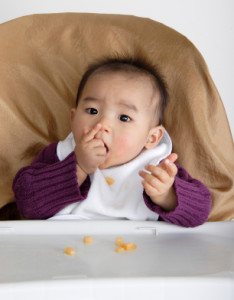2 Favourite, Filling Salads
/Full-meal salads are my absolute go-to during the summer months. And, with the growing trend of salads-in-a-jar, I can see that others are catching on. The secret to a perfectly balanced, full-meal salad (that will actually fill you up) is to include whole grains, protein, and healthy fats along with all those veggies. I also like to include a sweet note (such as fresh or dried fruit) and something crunchy for texture. Often foods will do double duty, such as chopped nuts providing protein, healthy fat, and crunch.
Baby- and Kid-Friendly Version: Serve each salad component “deconstructed”, in it’s own little pile. Serve a small dish (ramekin) of the dressing on the side. Or, do a make-your-own salad bar with the ingredients. There is no extra work for baby-friendly, finger-foods – just place pieces on your baby’s tray.
Enjoy!
Protein Food Ideas:
- Beans and lentils, canned or cooked from dry
- Edamame
- Tofu cut into cubes or fingers
- Grated or cubed cheese
- Leftover meat and poultry, e.g. shredded chicken, sliced steak
- Chopped or slivered nuts
- Seeds, e.g. pumpkin seeds, hemp hearts
- Hard boiled eggs
Whole Grain Ideas (Starch Foods):
- Cooked and cooled pasta
- Buckwheat (soba) noodles
- Brown rice
- Wild rice
- Quinoa
- Farro
- Pot barley
- Cooked and cubed sweet potatoes
For inspiration, here are two of my favourite full-meal salads. You’ll notice that there aren’t amounts listed for the salad ingredients – make as much or as little as you want.
Black Bean Salad
Ingredients
Brown rice
Black beans
Bell pepper (red, yellow, or orange)
Corn (cooked from frozen or cut off the cob)
Avocado
Dressing
1 TBSP Vegetable oil (I particularly like avocado oil)
1 TBSP White wine vinegar
2 TBSP Lime juice
1/4 tsp Ground cumin
1/8 tsp Cayenne pepper (optional)
Pinch Salt
Lentil-Farro Salad
Ingredients
Farro, cooked and cooled
Green lentils*, cooked and cooled
Grated carrot
Grated beet
Kale, cut into thin ribbons and massaged with a dash of oil, vinegar and salt
Slivered almonds
Raisins
Dressing
1 TBSP Good, extra virgin olive oil
3 TBSP Balsamic vinegar
Fresh cracked pepper
Pinch Salt
* Do you have difficulty digesting beans? Give lentils a try, they’re less “musical”, and check out my tips for making beans and lentils less gassy.










 {Guest post I contributed to the
{Guest post I contributed to the  {Guest Post at
{Guest Post at 